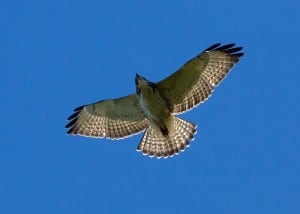On Sunday (Sept. 14), I witnessed a large southward movement of mostly Broad-winged Hawks over the Cordova Mines area, north of Havelock. I counted 168 of them in one kettle (loose group of hawks soaring in a thermal). It always seems easiest to count them accurately when they glide from one thermal to the next, (unlike when they are actually soaring around in a thermal.) I did see others during the day, as well, including 27 sailing between thermals over Stoney Lake. In total, for the day, I had 216 Broad-wingss, as well as 5 Red-shouldered Hawks (one immature, and four adults), 2 Red-tailed Hawks, 7 Turkey Vultures and 1 Cooper’s Hawk.
The four adult Red-shouldereds make up the two closest breeding pairs, one pair which has its nest a little over 1km south of my house, and the other, a little less than 1km north of my house. They will actually stay on territory here until late October – early November. Our house seems to be roughly on the border of the two territories, and we see, (but more often hear) them, sometimes almost daily from March until they are gone south before the snow comes. Residents and migrants will both be seen on great soaring days in the fall, but you just have to learn to guess which are which based on experience with each species, timing of normal migrational movement for each species, and observing the daily routines and habits of local breeding hawks, if you are hoping to count migrants separately from resident birds.
Monday (Sept. 15) was also a good day, at least for variety. I had 24 Broad-wings, 19 Turkey Vultures, 3 Bald Eagles (two adults and one third year bird), 1 Red-tailed, 1 Cooper’s, 2 Sharp-shinned and 2 Merlin. I am now at 161 Monarchs for the year, and it appears that my two or three day dry spell for them is now over, as they seem out and about once again.
Tim Dyson, Cordova Mines
